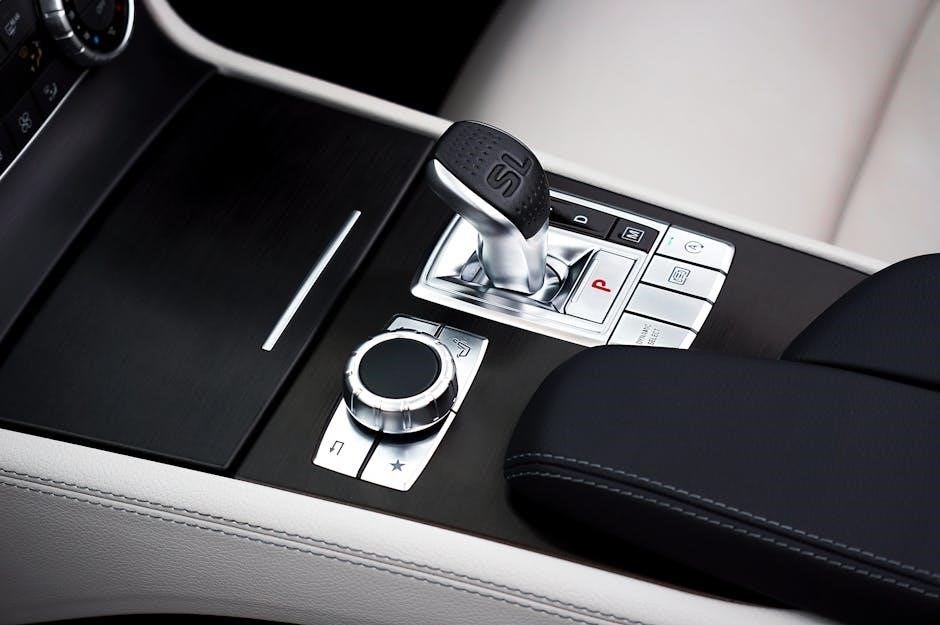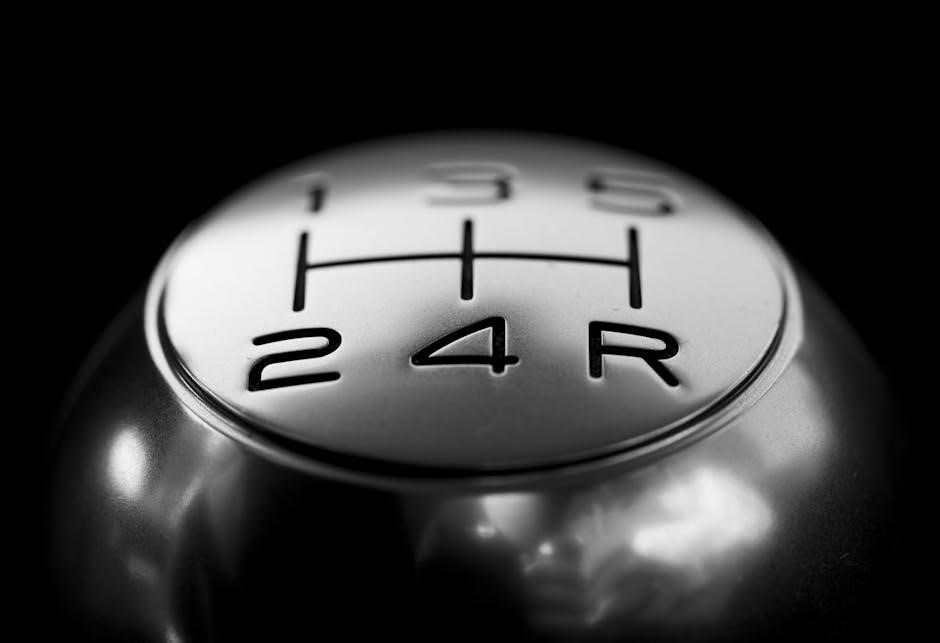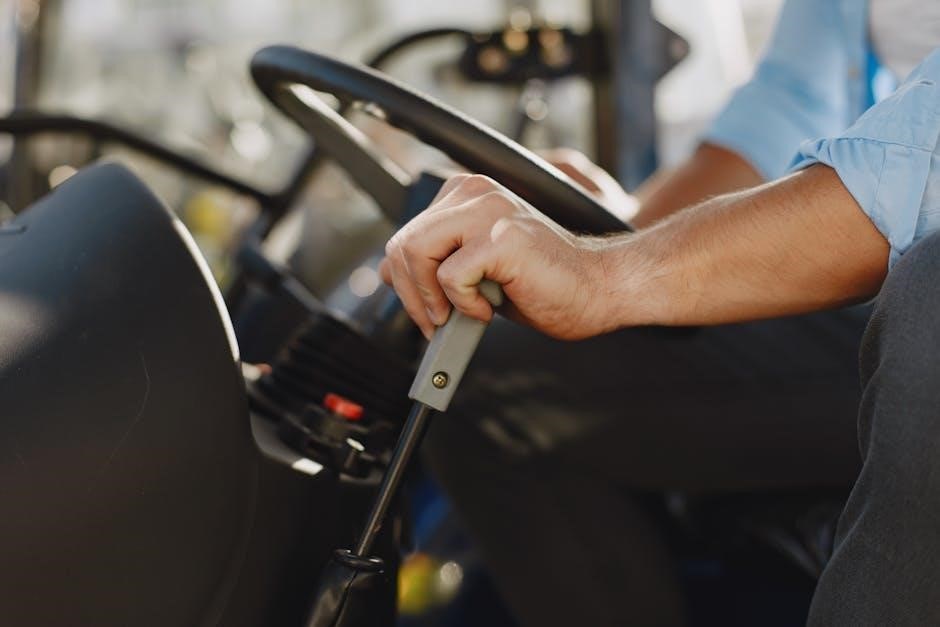Overview of 7-Speed Manual Transmissions
The 7-speed manual transmission offers drivers enhanced control and precision. It allows optimal engine speed management, maximizing performance.

Advantages of 7-Speed Manual Transmissions
7-speed manuals provide complete driver control, free from electronic aids. The driver can predictively operate the transmission, adapting to conditions better than any automatic.
Enhanced Driver Control
The primary advantage of a 7-speed manual transmission lies in the enhanced level of control it offers to the driver. Unlike automatic transmissions that rely on programmed algorithms to determine gear shifts, a manual transmission puts the driver firmly in command of the vehicle’s performance. This direct connection allows for a more engaging and responsive driving experience, enabling drivers to precisely select the optimal gear for any given situation. Whether it’s accelerating out of a corner, navigating challenging terrain, or simply cruising down the highway, the driver has the ability to tailor the engine’s output to their specific needs and preferences. This level of control is particularly appealing to driving enthusiasts who appreciate the tactile feedback and sense of mastery that comes with operating a manual transmission. Furthermore, the ability to anticipate and react to changing road conditions allows for smoother and more efficient driving, ultimately enhancing both the enjoyment and safety of the driving experience. In essence, the 7-speed manual transmission empowers drivers to become more intimately connected with their vehicle, fostering a deeper understanding of its capabilities and limitations.
Improved Fuel Efficiency
While often associated with performance and driver engagement, 7-speed manual transmissions can also contribute to improved fuel efficiency. The key to this lies in the greater number of gear ratios available compared to transmissions with fewer gears. With seven distinct gears, the engine can operate closer to its optimal RPM range for a wider range of speeds. This allows the driver to select a gear that maximizes fuel economy, especially during highway cruising. By keeping the engine in its most efficient RPM band, the transmission minimizes fuel consumption and reduces emissions. This is particularly noticeable at higher speeds, where the taller gear ratios can significantly lower engine RPM, resulting in less fuel being burned. Furthermore, the direct power transfer inherent in manual transmissions, compared to the fluid coupling in automatics, minimizes power loss and contributes to better fuel economy. The driver’s ability to select the most appropriate gear for the driving conditions also plays a crucial role in optimizing fuel efficiency. By anticipating upcoming changes in speed or terrain, the driver can proactively shift gears to maintain the engine within its most efficient operating range. In essence, the 7-speed manual transmission offers a balance of performance and fuel efficiency, catering to both driving enthusiasts and environmentally conscious drivers alike. The added gear allows you to keep the engine at a lower RPM.

Disadvantages and Considerations
Despite their advantages, 7-speed manuals have drawbacks. These include increased complexity, higher costs, and the potential for driver error.
Complexity and Cost
The intricate design of a 7-speed manual transmission introduces significant complexity compared to transmissions with fewer gears. This complexity directly translates to increased manufacturing costs, as more components are required, and the assembly process becomes more involved. Furthermore, the specialized knowledge and precision needed for the production of these transmissions contribute to higher labor expenses. Beyond the initial purchase price, the complexity of a 7-speed manual can also lead to increased maintenance and repair costs over the vehicle’s lifespan. The greater number of internal parts means there are more potential points of failure, and specialized technicians may be required for certain repairs. This can make routine maintenance and unexpected repairs more expensive than those for vehicles equipped with simpler transmissions. The cost factor is also a consideration in the design and development phase, potentially limiting the adoption of 7-speed manuals to higher-end sports cars or performance vehicles where the price point can accommodate the added expense. Therefore, while offering performance advantages, the complexity and cost associated with 7-speed manual transmissions remain significant considerations for both manufacturers and consumers. The cost is also a factor in the design phase.
Potential for Driver Error
The increased number of gears in a 7-speed manual transmission introduces a higher potential for driver error, particularly for those less experienced with manual gearboxes. The close ratios between gears demand more precise and timely shifting to maintain optimal engine performance and avoid stalling or lugging the engine. This heightened level of engagement requires a greater degree of driver skill and attentiveness. Incorrect gear selection can lead to jerky acceleration, reduced fuel efficiency, and even potential damage to the transmission or engine over time. Novice drivers may find it challenging to master the shifting patterns and clutch control necessary for smooth operation, especially in demanding driving conditions such as stop-and-go traffic or steep inclines. Even experienced manual drivers may occasionally find themselves in the wrong gear, particularly when rapidly downshifting or accelerating. The complexity of the 7-speed system can also lead to confusion when skipping gears, potentially resulting in missed shifts or unintended gear engagements. While the added gears offer a wider range of performance options, they also increase the risk of driver-induced errors, which can negatively impact the driving experience and long-term reliability of the vehicle. Thus, mastering the 7-speed is a skill.

Comparison to Other Transmission Types
This section contrasts the 7-speed manual with automatics and dual-clutch transmissions. The focus will be on performance, efficiency, and driver involvement.
Manual vs. Automatic Transmissions
Manual transmissions, including 7-speed variants, provide complete driver control, eliminating electronic intervention. Drivers can anticipate conditions and shift accordingly, unlike even the best automatic transmissions. Manuals are generally more fuel-efficient due to direct power transfer and greater control over engine speed, optimizing performance. However, automatics offer easier operation, especially in heavy traffic, eliminating the need for constant shifting. Manuals also tend to be less expensive to purchase and maintain due to fewer automated parts. Automatic transmissions adapt to various driving situations, offering convenience, while manuals require more driver engagement. The choice depends on individual preferences, prioritizing control and efficiency versus ease of use. Modern automatics, with advanced technology, narrow the fuel efficiency gap, making the decision more nuanced. Manual transmissions provide a visceral driving experience and a direct connection to the vehicle. The preference often hinges on driving style and the desired level of driver involvement. The 7-speed manual aims to blend the benefits of both, offering more gear options for efficiency and control.
Manual vs. Dual-Clutch Transmissions (DCT)
Manual transmissions, including 7-speed configurations, offer direct driver control over gear selection and clutch engagement, providing a traditional, engaging driving experience. In contrast, Dual-Clutch Transmissions (DCTs) automate the shifting process, using two separate clutches for odd and even gears, resulting in faster and smoother gear changes than a conventional manual. DCTs offer performance benefits in terms of acceleration and shift speed, often exceeding that of a skilled manual driver. While manuals require the driver to operate the clutch and shift lever, DCTs can be operated in automatic mode or with paddle shifters, offering a blend of convenience and control. A 7-speed manual gives the driver more gear choices for optimal engine performance and fuel efficiency. DCTs, however, use sophisticated electronic controls to optimize gear selection and shift timing, potentially leading to better fuel economy and quicker acceleration in certain situations. The manual gearbox emphasizes driver involvement and a mechanical connection to the car, while DCTs prioritize speed and efficiency. The 7-speed manual provides a wider range of gear ratios for different driving conditions, allowing the driver to fine-tune the engine’s output. Ultimately, the choice depends on the driver’s preference for control, engagement, and performance versus convenience and automation.

Vehicles Featuring 7-Speed Manual Transmissions
The adoption of 7-speed manual transmissions has been relatively limited, primarily appearing in high-performance sports cars and niche vehicles. The most notable example of a production vehicle featuring a 7-speed manual is the Porsche 911, specifically the 991 generation. Porsche introduced this gearbox to enhance both performance and fuel efficiency, providing closer gear ratios for optimal acceleration and a taller top gear for relaxed highway cruising. Another vehicle that briefly offered a 7-speed manual was the Chevrolet Corvette C7. This transmission aimed to improve fuel economy and offer a more engaging driving experience. Beyond these prominent examples, 7-speed manuals are rare in mainstream vehicles. Some manufacturers may use similar gearboxes in racing or limited-edition models, but these are not widely available to the general public. The decision to equip a vehicle with a 7-speed manual often reflects a focus on driver involvement and performance characteristics. While automatic and dual-clutch transmissions dominate the market, a 7-speed manual offers a unique blend of control and efficiency for enthusiasts. Certain off-road vehicles or specialized trucks might incorporate multi-speed manual gearboxes, but the 7-speed configuration is more common in sports cars. These vehicles benefit from the closer ratios, allowing drivers to maintain optimal engine speed in various conditions.
Future of Manual Transmissions
The future of manual transmissions, including 7-speed variants, appears uncertain amidst the increasing dominance of automatic and dual-clutch transmissions (DCTs). While manual gearboxes offer a unique driver engagement and a sense of control, they face challenges from technological advancements and shifting consumer preferences. Automatics and DCTs provide improved fuel efficiency, faster acceleration, and greater convenience, making them increasingly appealing to a broader audience. However, a dedicated group of enthusiasts still appreciates the visceral experience of driving a manual. For these drivers, the connection to the car and the control over gear selection remain highly valued. As a result, some manufacturers may continue to offer manual transmissions in niche models, particularly sports cars and performance vehicles. The 7-speed manual, while rare, represents an attempt to blend the benefits of a manual with improved efficiency. Whether it will see wider adoption remains to be seen. Factors such as stricter emissions regulations and the development of advanced driver-assistance systems could further impact the future of manuals. Ultimately, the survival of manual transmissions depends on the continued demand from driving enthusiasts and the ability of manufacturers to innovate and adapt to changing market conditions. Some predict a resurgence of interest in simpler, more engaging driving experiences, which could lead to a renewed appreciation for manual gearboxes. Others believe that electric vehicles and autonomous driving technologies will eventually render them obsolete. Regardless, the manual transmission holds a special place in automotive history and will likely remain a topic of debate and nostalgia for years to come. The key will be finding a balance between performance, efficiency, and driver enjoyment.



